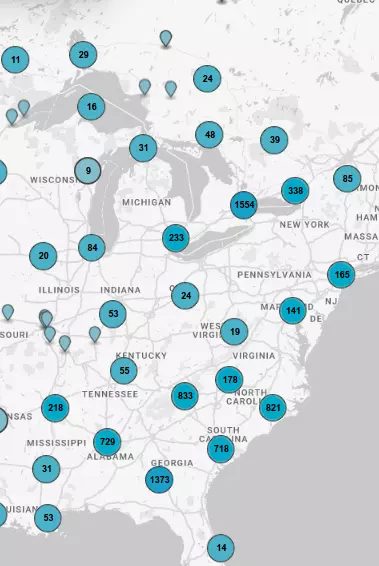Old Stagecoach Road
This road is one of the oldest in North Georgia. In the Indian days it connected Hightower Trail to the Etowah Mounds and Cherokee country with trails to Coweta Falls (Columbus), the Chief...
- lat34
The 1836 Fort
In May of 1836 the 88th Regiment of the Georgia Militia built a small fort in anticipation of an attack by the Creek Indians. The Steamer Georgian had arrived crowded with women and...
- lat34
Old Pioneer Cemetery
This was the first established Cemetery of Fort Gaines. The earliest death date on a stone marker is 1830. The Tombs of Georgia Militia General John Dill and his family are found in an enclosed...
- lat34
Oketeyeconne (Side 1)
Oketeyeconne, or Okitiyakani, was a Hitchiti- speaking Lower Creek town located near here on the east bank of the Chattahoochee River south of Sandy Creek during the late frontier...
- lat34
New Lowell United Methodist Church
[Side 1] The area was settled about 1820 along the falls of Pataula Creek in a community knows as Lowell. The falls provided water power for several commercial enterprises including a new...
- lat34
Mt. Gilead Baptist Church
This church was constituted on July 21, 1822, under the leadership of the Reverend Jim Davis, when Fort Gaines was part of Early County. Land for the church was donated and deeded by J. Hugh Edge....
- lat34
Founding of Fort Gaines (Side 2)
A military garrison, later named Fort Gaines, was established on the Chattahoochee River in 1814 to patrol the buffer against the British and hostile Indians created by the land ceded in the...
- lat34
Chattahoochee Theater (Side 2)
(Continued from other side) William and Thomas Perryman became leaders of the war faction of the Lower Creeks and Seminoles. Their settlement, nown as Perryman, on the Chattahoochee above the...
- lat34
Clay County Courthouse
Clay County Courthouse is the oldest courthouse in the Pataula Judicial Circuit and one of the oldest in South Georgia. Construction began in 1871 and it was completed in 1873 as shown by grand...
- lat34
Oakland High School
Founded in the 1880´s Oakland High School´s name was derived from oak trees which grewin abundance at this location when the school building was constructed. The school originally had 10...
- lat34
The Old Lattice Bridge (two sided)
(front) The second covered bridge across the Chattahoochee River, connecting Clay County, Georgia and Henry County. Alabama was constructed between 1867-69. Bonner and Walden, a New...
- lat34
1814 Boundary (Side 1)
The boundary line defined in the Treaty of Fort Jackson (August 1814) between the confederated Creek tribes and the United States extended eastward from the mouth of Cemochechobee Creek south of...
- lat34
Gen. Edmund Pendleton Gaines
The son of James Gaines, Revolutionary soldier and relative of five Presidents, General Gaines (1777 - 1849) was born in Virginia. From 1801 to 1804 he built the military highway from Nashville,...
- lat34
Site of Fort Gaines Female College
In 1857, the Legislature authorized a lottery to complete this college, chartered in 1838 as Fort Gaines Female Institute. It was finished in 1859. Sereno Taylor was the first principal, followed...
- lat34
Fort Gaines Guards
Organized in 1836 under the command of Col. J. E. Brown, for 74 years the Fort Gaines Guards was one of the best and, later, the oldest military organization in western Georgia. Kept...
- lat34
Fort Gaines
One of several forts on Georgia's western frontier for the protection of white settlers, Fort Gaines was established in 1816 by order of Gen. Edmund P. Gaines, commander of a large district, who...
- lat34
In the Confederacy
CONFEDERATE FORT - To protect Fort Gaines from Federal gunboats, Confederate Army engineers in 1863 laid out a fort here, commanding a full view of the river for two miles below. A large...
- lat34
Queen City of the Chattahoochee
Known by the Indians as A-Con-Hollo-Way Tal-lo fa (Highland Town), Fort Gaines, established as a frontier fort in 1816 by Gen. Edmund P. Gaines, was chartered as a town in 1830 and named for...
- lat34
Historic Sites
DILL HOUSE - John Dill (1788-1856) of S.C., military aide to Gen. Gaines, commander of Fort Gaines, and leading pioneer citizen, is said to have built this house, "the finest home on...
- lat34
Old Cotton Hill Seminary
Here stood the Cotton hill Male and Female Seminary incorporated by an Act of the Legislature March 6, 1856, but in existence before that time. Professor Norman Flavius Cooledge, uncle...
- lat34
